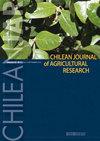乌拉圭不同种植环境下大豆对施用腐殖质生物刺激素的反应
IF 1.5
4区 农林科学
Q2 AGRICULTURE, MULTIDISCIPLINARY
引用次数: 0
摘要
大豆(甘氨酸max (l))小麦是乌拉圭的一种重要作物,其产量不断增加,注定要出口,但过去几年受到干旱的不利影响。评估一种生物刺激素在野外条件下有效性的一致性需要在不同地点进行多年的重复试验。本研究的主要目的是评估在8年(2014年至2021年)期间(2014年至2021年),在156个具有不同土壤和水分条件的农田中,施用一种腐殖质生物刺激素(HB),剂量为4 L ha-1,剂量为r2 - r4,对大豆作物的影响。测定土壤质量和生产能力的CONEAT指数和有效降雨量(eR)对每个大豆农田进行了评价。未处理植株的平均籽粒产量从8.83 g(2018)到19.93 g(2017)不等,生物刺激素处理植株的平均籽粒产量从10.20 g(2018)到24.01 g(2017)不等。籽粒产量(g株-1)与CONEAT指数和eR指数相关性较差。同样,对HB处理的产量响应(%)与环境指标无关,这表明考虑到土壤生产力和降雨量,生物刺激剂的作用相对恒定和积极,不依赖于环境。农场试验的产量成分分析认为,腐植酸提高产量的主要原因是在不影响籽粒重量的情况下增加了豆荚保留率。总体而言,多年来所有农场试验的数据分析表明,与未处理的植物相比,处理显著提高了大豆产量,平均提高了16.3%。这些结果证实,HB可以纳入乌拉圭大豆生产的正常管理计划。本文章由计算机程序翻译,如有差异,请以英文原文为准。
On-farm soybean response to a field foliar applied humic biostimulant at differing cropping environments of Uruguay
Soybean (Glycine max (L.) Merr.) is an important crop in Uruguay with increasing production destined to exports that has been negatively affected by drought in the last years. Assessing the consistency of a biostimulant efficacy in field conditions involves multiyear replication across locations. The main objective of this study was to evaluate the effects of a single treatment with a humic biostimulant (HB) field foliar-applied at R3-R4 at dose of 4 L ha-1 on soybean crops grown during 8 yr (2014 to 2021) at 156 farm sites with different soil and water conditions on the main country cropping areas. The CONEAT index that measures soil quality and production capacity, and effective rainfall (eR) were assessed for each soybean farm site. The average grain yield varied from 8.83 (2018) to 19.93 g (2017) per untreated plants, and from 10.20 (2018) and 24.01 g (2017) per biostimulant-treated plants. The means for grain yield (g plant-1) by site were poorly related to the CONEAT and the eR indices. Similarly, the yield response to HB treatment ((%) was not related to the environmental indices which indicates a relatively constant and positive effect of the biostimulant independent of the environment, considering soil productivity and rainfall. Yield component analysis at the farm trials attributed the yield boosts by the humic largely to increased pod retention without affecting the grain weight. Overall, data analyses from all the farm trials across the years showed that the treatment significantly increased soybean yield by an average of 16.3% relative to the untreated plants. These results confirm that HB can be incorporated into the normal management plan for soybean production in Uruguay.
求助全文
通过发布文献求助,成功后即可免费获取论文全文。
去求助
来源期刊

Chilean Journal of Agricultural Research
AGRICULTURE, MULTIDISCIPLINARY-AGRONOMY
CiteScore
3.10
自引率
11.80%
发文量
60
审稿时长
6-12 weeks
期刊介绍:
ChileanJAR publishes original Research Articles, Scientific Notes and Reviews of agriculture, multidisciplinary and agronomy: plant production, plant protection, genetic resources and biotechnology, water management, soil sciences, environment, agricultural economics, and animal production (focused in ruminant feeding). The editorial process is a double-blind peer reviewing, Editorial Office checks format, composition, and completeness, which is a requirement to continue the editorial process. Editorial Committee and Reviewers evaluate relevance and scientific merit of manuscript.
 求助内容:
求助内容: 应助结果提醒方式:
应助结果提醒方式:


